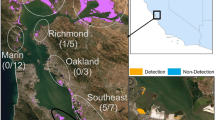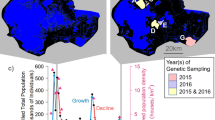Abstract
The key patch approach assumes that metapopulations in fragmented landscapes are likely to be viable with at least one “key” sub-population that is sufficiently large to ensure re-colonization of surrounding minor habitat patches. It is based on a minimum viable number of breeding pairs and within-breeding season dispersal distance, linked to size of the animal and longevity. It was tested using census data of 15 wetland bird species (bearded tit, bluethroat, great reed warbler, sedge warbler, Savi’s warbler, grasshopper warbler, spotted crake, water rail, common snipe, common teal, garganey, little bittern, night heron, great bittern and marsh harrier) in 14 wetland complexes of variable size (3–55 km2) spread across the Netherlands (distances ranging 4–156 km). First, for each species it was assessed whether a wetland harbored a key subpopulation, which was the case for the sedge warbler (7 key subpopulations), grass-hopper warbler (2), water rail (2), bearded tit, bluethroat, Savi’s warbler, common teal, garganey, great bittern and marsh harrier (all one key subpopulation).Together with the adjacent sub-populations present within breeding season dispersal distance, 10 out of the 15 studied species formed viable meta-populations. This was compared with the trend in the census data of 13 species for 1990–2000 and was found to correspond significantly (likelihood ratio test, P = 0.003): species without a viable meta-population had declined (2 out of 4) or remained stable (2 out of 4), whereas viable meta-populations had increased (6 out of 9) or remained comparatively stable (2 out of 9). One wetland complex, the Oostvaardersplassen, stood out in that it haboured key sub-populations for 9 out of the 15 species studied. Variation in quantity of specific habitat (area or perimeter marshland, woodland or open water) in a wetland complex was of limited importance explaining abundance patterns, since all covaried strongly with total area among the wetland complexes, with the exception of water perimeter. Apparently, these wetlands on peat harbour largely similar landscapes. Indeed, population sizes of most birds covaried strongly and in a PCA two distinct clusters of species were identified that shared high numbers of breeding pairs in the same, larger, wetland complexes, the first (3 species) including the great reed warbler, and the second (9 species) the water rail.



Similar content being viewed by others
References
Andelman SJ, Fagan WF (2000) Umbrellas and flagships: efficient conservation surrogates or expensive mistakes? Proc Natl Acad Sci 97:5954–5959. doi:10.1073/pnas.100126797
Barendregt A, Wassen MJ, Schot PP (1995) Hydrological systems beyond a nature reserve, the major problem in wetland conservation of Naardermeer (The Netherlands). Biol Conserv 72:393–405. doi:10.1016/0006-3207(94)00101-U
Bailey SA, Haines-Young RH, Watkins RC (2002) Species presence in fragmented landscapes: modelling of species requirements at the national level. Biol Conserv 108:307–316. doi:10.1016/S0006-3207(02)00119-2
Bakker SA, Van den Berg NJ, Speelers BP (1994) Vegetation transitions of floating wetlands in a complex of turbaries between 1937 and 1989 as determined from aerial photographs with GIS. Vegetatio 114:161–167
Both C, Bouwhuis S, Lessells CM, Visser ME (2006) Climate change and population declines in a long-distance migratory bird. Nature 441:81–83. doi:10.1038/nature04539
Brawn JD, Robinson SK (1996) Source-sink population dynamics may complicate the interpretation of long-term census data. Ecology 77:3–12. doi:10.2307/2265649
CBS (2000) Bestand bodemgebruik/Netherlands digital land use map. Netherlands Statistics Service, Voorburg
Dias PC (1996) Sources and sinks in population biology. Trends Ecol Evol 11:326–330. doi:10.1016/0169-5347(96)10037-9
Fahrig L (2003) Effects of habitat fragmentation on biodiversity. Ann Rev Ecol Evol Syst 34:487–515. doi:10.1146/annurev.ecolsys.34.011802.132419
Foppen RFB, Chardon JP, Liefveld W (2000) Understanding the role of sink patches in source-sink meta-populations: reed warbler in an agricultural landscape. Conserv Biol 14:1881–1892. doi:10.1046/j.1523-1739.2000.99022.x
Frank K, Wissel C (1998) Spatial aspects of metapopulation survival—from model results to rules of thumb for landscape management. Landsc Ecol 13:363–379. doi:10.1023/A:1008054906030
Graveland J (1998) Reed die-back, water level management and the decline of the Great Reed Warbler Acrocephalus arundinaceus in The Netherlands. Ardea 86:187–201
Hanski I (1999) Metapopulation ecology. Oxford University Press, New York
Henle K, Davies KF, Kleyer M, Margules C, Settele J (2002) Predictors of species sensitivity to fragmentation. Biodiv Conserv 13:207–251. doi:10.1023/B:BIOC.0000004319.91643.9e
Jongman RHG (2002) Homogenisation and fragmentation of the European landscape: ecological consequences and solutions. Landsc Urb Plann 58:211–221. doi:10.1016/S0169-2046(01) 00222-5
Jonsson L (1998) Complete gids Vogels van Nederland, Europa, Noord-Afrika en het Midden-Oosten, Vereniging Natuurmonumenten (in Dutch)
Knol WC, Kramer H, Dorland GJ, Gijsbertse H (2003) Historisch grondgebruik Nederland: tijdreeksen grondgebruik Noord-Holland van 1850-1980. Wageningen, Alterra. Alterrareport 751 (in Dutch)
Leibold MA, Holyoak M, Mouquet N, Amarasekare P, Chase JM, Hoopes MF, Holt RD, Shurin JB, Law R, Tilman D, Loreau M, Gonzalez A (2004) The metacommunity concept: a framework for multi-scale community ecology. Ecol Lett 7:601–613. doi:10.1111/j.1461-0248.2004.00608.x
Opdam P, Wasscher D (2004) Climate change meets habitat fragmentation: linking landscape and biogeographical scale levels in research and conservation. Biol Conserv 117:285–297. doi:10.1016/j.biocon.2003.12.008
Pulliam HR, Danielson BJ (1991) Sources, sinks, and habitat selection: a landscape perspective on population dynamics. Am Nat 137:S50–S66. doi:10.1086/285139
Reed DH, O’Grady JJ, Brook BW, Ballou D, Frankham R (2003) Estimates of minimum viable population sizes for vertebrates and factors influencing those estimates. Biol Conserv 113:23–34. doi:10.1016/S0006-3207(02) 00346-4
Reijnen R, Foppen R (1994) The effects of car traffic on breeding bird populations in woodland. I. Evidence of reduced habitat quality for Willow Warblers Phylloscopus trochillus breeding close to a highway. J Appl Ecol 31:85–94. doi:10.2307/2404601
Soldaat L, Visser H, Van Roomen M, Van Strien A (2007) Smoothing and trend detection in waterbird monitoring data using structural time-series analysis and the Kalman filter. J Ornithol 148(Supplement 2):S351–S357. doi:10.1007/s10336-007-0176-7
Verboom J, Foppen R, Chardon P, Opdam P, Luttikhuizen P (2001) Introducing the key patch approach for habitat networks with persistent populations: an example for marshland birds. Biol Conserv 100:89–101. doi:10.1016/S0006-3207(00) 00210-X
Verhoeven JTA (ed) (1992) Fens and bogs in The Netherlands, vegetation, history, nutrient dynamics and conservation. Kluwer, Dordrecht Geobotany 18
Vermaat JE, Goosen H, Omtzigt N (2007) A multivariate analysis of biodiversity patterns in Dutch wetland marsh areas: urbanisation, eutrophication or fragmentation? Biodiv Conserv 16:3585–3595. doi:10.1007/s10531-006-9128-4
Acknowledgements
The numerous bird watching volunteers and their organisations cooperating with SOVON to collect bird distribution data and compile these for free access are thanked here. Without them comparative analyses like the present study are impossible. The critical comments of two referees distinctly improved our paper.
Author information
Authors and Affiliations
Corresponding author
Rights and permissions
About this article
Cite this article
Vermaat, J.E., Vigneau, N. & Omtzigt, N. Viability of meta-populations of wetland birds in a fragmented landscape: testing the key-patch approach. Biodivers Conserv 17, 2263–2273 (2008). https://doi.org/10.1007/s10531-008-9401-9
Received:
Accepted:
Published:
Issue Date:
DOI: https://doi.org/10.1007/s10531-008-9401-9




